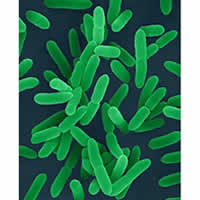Y. enterocolitica: Difference between revisions
| Line 33: | Line 33: | ||
===Iron and pathogenicity=== | ===Iron and pathogenicity=== | ||
<i> Y. enterocolitica </i> is unable to chelate iron. Despite not being able to produce siderophores-- <i> Y. enterocolitica </i> can utilize siderophores produced by other bacteria. | <i> Y. enterocolitica </i> is unable to chelate iron. Despite not being able to produce siderophores-- <i> Y. enterocolitica </i> can utilize siderophores produced by other bacteria [1]. | ||
==Epidemiology== | ==Epidemiology== | ||
Revision as of 08:56, 17 July 2014

Etiology/Bacteriology
Taxonomy
| Domain = Bacteria | Phylum = Proteobacteria | Class = Gammaproteobacteria | Order = Enterobacteriales | Family = Enterobacteriaceae | Genus = Yersinia | species = Y. enterocolitica
Description
Pathogenesis
Transmission
Yersinia enterocolitica is found in meats (pork, beef lamb ect) fish, and raw milk. Exact reason for food contamination is unknown [2]. Yersinia enterocolitica infection results in yersiniosis—a zoonotic disease that occurs in humans, cattle deer, birds and pigs [2]. Only a few strains cause infection in humans, and children are infected more often than adults. There are over 60 serotypes for Yersinia enterocolitica . The serotypes pathogenic to humans are O:3, O:5,27, O:8, O:9, and O:13 [1,2].
Invasion
Y. enterocolitica can efficiently colonize the small intestine. After entering the host, bacteria colonize on the lumen and invade the epithelial lining—resulting in peyer patches [1]. Y. enterocolitica colonization requires the transfer of the bacteria across the epithelial tissue barrier. Produces 3 invasions proteins—Ail, YadA and invasin [1]. These proteins promote adherence and invasion of M cells, a type of antigen-sampling intestinal epithelial cells.
Infectious dose, incubation, and colonization
The infectious dose for Yersinia enterocolitica is currently unknown. Illness takes place between 24 and 48 hours after ingestion [3]. Illness typically presents as Diarrhea—sometimes bloody—low-grade fever, abdominal pain and vomiting is present in 15-40% of cases [1]. Yersiniosis is a less common infection, because most food processing techniques eliminate the risk for infection [3].
Virulence Factors
Enterotoxicity
The enterotoxin produced by Y. enterocolitica is similar to E. coli . Nevertheless, the enterotoxin only plays a minor role in pathogenesis, because diarrheal symptoms have been observed with the absence of enterotoxin formation [1]. The outer membrane antigens are associated with bacterial resistance to opsonization and neutrophil phagocytosis [1]
Iron and pathogenicity
Y. enterocolitica is unable to chelate iron. Despite not being able to produce siderophores-- Y. enterocolitica can utilize siderophores produced by other bacteria [1].
Epidemiology
The most susceptible populations to Y. enterocolitica are small children, immuno-suppressed, and the elderly [3]. 75% of patients are between the age of 5-15 years [1]. Most isolates of the disease are type O:3 and O:9 serotypes in Canada and Europe. In the US it is estimated that approximately 5% of bacterial enteric infections for children under the age of 5.The CDC claims 17,000 cases annually in the United States [2]. The disease is much more common in Northern Europe, Scandinavia, and Japan.
Clinical Features
Yersinia enterocolitica normally causes diarrhea in all manifestations of the infection, with some severe cases having blood in the stools. Aside from diarrhea the disease may present differently when comparing adult and adolescent cases. Pediatric cases are characterized by fever, abdominal pain and more commonly present with bloody diarrhea. The most common presentation of Y. enterocolitica in children is enterocolitis. The symptoms include watery and mucoid diarrhea, fever and colicky abdominal pain, with blood and white blood cells in stools. Adults describe their symptoms as diarrhea, localized lower right quadrant abdominal pain, vomiting, and low-grade fever. Often the infection will clear without the aid of antibiotics, but those that do not may display more severe side effects including: red or purple raised lesions known as erythema nodosum and joint pain commonly in the knees, wrists or ankles. Erythema nodosum lesions appear 2-20 days after the onset of the infection and also resolve without medical treatment in about a month. Lesions are more commonly seen in females and appear on the patient’s trunk and legs. Joint pain may manifest about a month after the onset of symptoms and cease after 1 to 6 months. Septicemia, or bacteria in the blood, can occur in adults with predisposing conditions, such as diabetes mellitus, immune defect, alcoholism, thalassemia, sickle cell disease, or hemochromatosis. Septicemia can also cause metastatic infections including abscesses in the liver, spleen, kidneys and lungs.
Diagnosis
There are numerous tests that can be used to diagnose a Yersinia enterocolitica infection. A stool culture is the best way to confirm the presence of the pathogen but can take two weeks since the onset of the disease for the culture result to come back positive. Other tests include tube agglutination, enzyme-linked immunosorbent assays, radioimmunoassays, ultrasonography or computed tomography scanning imaging studies, colonoscopy, and joint aspiration in certain cases. A vast majority of Y. enterocolitica infections will clear up on their own with good nutrition and hydration. Severe or complicated infections can be treated with the antibiotics aminoglycosides, doxycycline, trimethoprim-sulfamethoxazole, or fluoroquinolones.
Treatment
Infections by Yersinia enterocolitica are usually self-limiting and will resolve on their own in most patients who recover without any antibiotic treatment within a seven days to three weeks. Hydration is important in uncomplicated cases of diarrhea caused by the organism and will be sufficient treatment in the infection, however in severe or more complicated cases of infection antibiotic treatment may be necessary. The antibiotics commonly used are aminoglycosides, doxycycline, trimethoprim-sulfamethoxazole, or fluoroquinolones.
Prevention
Prevention of Yersinia enterocolitica infection is easy if one is aware of what to avoid. The most common mode of transmission is via poultry and livestock. Thus, avoid raw or undercooked meats. Make sure that milk products are pasteurized before consumption. If raw meat must be handled, clean hands thoroughly to avoid cross-contamination. Beware of cross-contamination in the kitchen by cleaning all surfaces and appliances with soap and hot water. Animal feces may also be contaminated so dispose of all animal waste properly.
Host Immune Response
References
Created by Emily Kurtz, Kristen Hoelscher, Dane Korber and Caitlyn Baukal, students of Tyrrell Conway at the University of Oklahoma
1. Medscape. http://emedicine.medscape.com/article/232343-overview
2. CDC. http://www.cdc.gov/ncidod/dbmd/diseaseinfo/yersinia_g.htm
3. FDA. http://www.fda.gov/Food/FoodborneIllnessContaminants/CausesOfIllnessBadBugBook/ucm070040.htm

